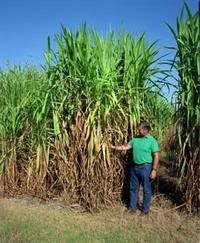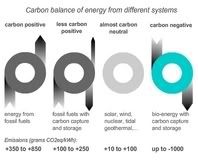Novel organic metal hybrids revolutionize materials science and chemical engineering - applications in biogas and biohydrogen storage
 A novel class of hybrid materials made from metals and organic compounds is changing the face of solid state chemistry and materials science just 10 years after its discovery, with applications already in safe storage of highly inflammable gases such as hydrogen and methane promising to make the introduction of biohydrogen and biomethane as transport fuels more feasible. Other applications of interest to the bioenergy community include efficient CO2 capture (for carbon-negative bioenergy systems), novel liquids separation processes in biofuel production (nanostructured molecular sieves) and the development of new catalysts.
A novel class of hybrid materials made from metals and organic compounds is changing the face of solid state chemistry and materials science just 10 years after its discovery, with applications already in safe storage of highly inflammable gases such as hydrogen and methane promising to make the introduction of biohydrogen and biomethane as transport fuels more feasible. Other applications of interest to the bioenergy community include efficient CO2 capture (for carbon-negative bioenergy systems), novel liquids separation processes in biofuel production (nanostructured molecular sieves) and the development of new catalysts.Europe is aiming to capitalise on core strengths in the field and build critical mass by combining the diverse range of skills required within a coherent research network, following a major workshop organised by the European Science Foundation (ESF).
The materials called Metal Organic Frameworks (MOFs) represent one of the biggest breakthroughs in solid state science whose potential is only just being realised, according to Gérard Ferey of the Institut Lavoisier at the University of Versailles, who convened the ESF workshop titled Genesis and Applications of Active Metal Organic Frameworks [*.pdf].
The domain is currently exploding, and there are so many potential applications that it is difficult to decide how to prioritise them. The only limit is our imagination. There is no doubt though that the first big application of MOFs - storage of gases - will be highly important, given the urgency of developing alternatives to fossil fuels for automobiles. For hydrogen storage, MOFs are already used, and many carmakers have these products in prototypes. - Gérard Ferey, Institut LavoisierMOFs are porous materials with microscopic sized holes, resembling honeycombs at molecular dimensions. This property of having astronomical numbers of tiny holes within a relatively small volume can be exploited in various ways, one of which is as a repository for gases. Gas molecules diffuse into the MOF solid and are contained within its pores.
In the case of gas storage, MOFs offer the crucial advantage of soaking up some of the gas pressure exerted by the molecules. This makes hydrogen derived from non-fossil energy sources such as biomass, or even genetically engineered plants, potentially viable as a fuel for cars while the alternative of pressurised canisters is not, says Ferey. The key difference is that the amount of gas stored in a conventional cylinder at say 200 atmospheres pressure could be accommodated in an MOF vessel of the same size at just 30 atmospheres, which is much safer:
 energy :: sustainability :: biomass :: bioenergy :: biofuels :: metal organic frameworks :: solid state chemistry :: materials science :: biofuels :: gas storage :: carbon capture :: biogas :: biohydrogen ::
energy :: sustainability :: biomass :: bioenergy :: biofuels :: metal organic frameworks :: solid state chemistry :: materials science :: biofuels :: gas storage :: carbon capture :: biogas :: biohydrogen :: The porous nature of MOFs enables them to be exploited in quite another way as catalysts to accelerate chemical reactions for a wide variety of materials production and pharmaceutical applications, although this field, as Ferey noted, is still in its infancy. Yet already the field is gaining interest beyond academia from serious companies, with a significant development at the ESF workshop being the presence and support of German chemicals giant BASF. This in turn has provided high endorsement of the field's potential and has stimulated interest from other companies, according to Ferey.
But several challenges remain before this potential can be realised, the first one being to assemble research and development teams with the right body of skills. As Ferey noted, many of the skills already exist but the researchers need to expand their horizons and focus more broadly on the big picture beyond their specialised domains.
There is also the technical challenge of learning first how these materials are formed, and then applying the knowledge to design MOFs matched to specific requirements. MOFs are crystalline solids that form in highly regular patterns from solutions, just as salts and sugars do. Researchers need to learn how to manipulate the starting conditions to obtain just the crystalline composition and arrangement they want.
The ESF Exploratory Workshop, Genesis and Applications of Active Metal Organic Frameworks, held in Dourdan near Paris in France in April 2007, was one of the first dedicated to this highly promising field whose potential has been underestimated until now. The next objective for Ferey is to establish a research network within the European Union's Seventh Framework Programme (FP7). Each year, ESF supports approximately 50 Exploratory Workshops across all scientific domains. These small, interactive group sessions are aimed at opening up new directions in research to explore new fields with a potential impact on developments in science.
Image: example of a nanoporous MOF's molecular structure. Credit: ESF.
References:
European Science Foundation, Standing Committee for Physical and
Engineering Sciences (PESC), Exploratory Workshop: Genesis and Applications of Active Metal-Organic Frameworks [*.pdf], Dourdan, France, 25 - 28 April 2007 Convened by: Gérard Ferey, Institut Lavoisier (UVSQ), Département de Chimie, Université de Versailles St. Quentin en Yvelines.
European Science Foundation: Novel organic metal hybrids that will revolutionize materials science and chemical engineering - February 18, 2008
Article continues
 --------------
--------------
 Sarnia-Lambton lands a $15million federal grant for biofuel innovation at the Western Ontario Research and Development Park. The funds come on top of a $10 million provincial grant. The "Bioindustrial Innovation Centre" project competed successfully against 110 other proposals for new research money.
Sarnia-Lambton lands a $15million federal grant for biofuel innovation at the Western Ontario Research and Development Park. The funds come on top of a $10 million provincial grant. The "Bioindustrial Innovation Centre" project competed successfully against 110 other proposals for new research money.


 Italian chemical group Mossi & Ghisolfi (M&G) plans to build a 200,000-tonne ethanol plant and convert it to using cellulose feedstock to make next-generation biofuels. M&G Vice President Guido Ghisolfi said the group with partners would invest €100 million (US$148.1 million) to build the plant in Italy by 2009 and €120 (US$175.9) more in research to convert it to cellulose feedstock later on.
Italian chemical group Mossi & Ghisolfi (M&G) plans to build a 200,000-tonne ethanol plant and convert it to using cellulose feedstock to make next-generation biofuels. M&G Vice President Guido Ghisolfi said the group with partners would invest €100 million (US$148.1 million) to build the plant in Italy by 2009 and €120 (US$175.9) more in research to convert it to cellulose feedstock later on.

 A team of crop geneticists in the United States have identified a key gene that determines oil yield in maize kernels, a finding that could have repercussions for the fast-expanding biofuels industry with applications in developing high yielding oil crops. Results are published as an advance online
A team of crop geneticists in the United States have identified a key gene that determines oil yield in maize kernels, a finding that could have repercussions for the fast-expanding biofuels industry with applications in developing high yielding oil crops. Results are published as an advance online 






Monday, February 18, 2008
Scientist explores deep ocean storage of carbon - another option for carbon negative bioenergy
At first blush, this might appear like science fiction, but it's an idea that gets serious attention from Dr. David Keith, one of Canada's foremost experts on carbon capture and sequestration. Keith will talk on the subject at the 2008 Annual Conference of the American Association for the Advancement of Science in Boston at a session entitled "Ocean Iron Fertilization and Carbon Sequestration: Can the Oceans Save the Planet?"
Shooting rockets full of sulphur into the high atmosphere to emulate the cooling effect of volcanic eruptions, launching space mirrors, making artificial reflective clouds, or building costly synthetic trees - there are a lot of gee-whiz (and risky) "geo-engineering" ideas for dealing with global warming that are really silly, remarks Keith, an NSERC grantee and director of the Energy and Environmental Systems Group at University of Calgary-based Institute for Sustainable Energy, Environment and Economy. At first glance his own idea looks nutty, but as one looks closer it seems that it might technically feasible with current-day technology. But, adds Keith, who holds the Canada Research Chair in Energy and the Environment, it's early days and there is not yet any serious design study for the concept.
Carbon storage is receiving more and more attention as climate change needs radical interventions. Capturing and storing CO2 from (biomass) power plants and other point sources comes in a variety of forms:
- the gas can be captured and stored in geological formations such as depleted oil and gas fields, saline aquifers, unmineable coal seams or special rock formations; this storage technique is called "geosequestration"
- alternatively, carbon can be captured and stored either in gaseous or in a solid form at the bottom of the ocean, where it would remain contained for millennia - "ocean storage"
- carbon dioxide can also be captured and transformed into stable, inert products, via mineralisation processes
- last but not least, carbon can be stored in an inert form in soils; this technique is based on biochar, obtained from biomass; soil sequestration has many advantages: it is both relatively simple and cost-effective, and improves soil qualities considerably; biochar systems yield negative emissions, because the biomass delivers both energy as well as a carbon sink
All these carbon sequestration techniques can be applied to CO2 from biomass power plants and decarbonised biofuel production. In this case, a "negative emissions" energy system can be designed that removes CO2 emissions from the past. Actively taking CO2 out of the atmosphere with such carbon-negative bioenergy systems, is the most radical tool in the climate fight. No other energy system can become carbon negative. Such bio-energy with carbon storage (BECS) systems are seen as one of the few cost-effective, feasible and safe geo-engineering option.But these systems require efficient carbon capture, transportation and storage strategies. Biopact has been focusing both on carbon capture and storage (CCS) based on geosequestration and biochar, but ocean storage could be an alternative.
The original idea of ocean storage was conceived several years ago by Dr. Michael Pilson, a chemical oceanographer at the University of Rhode Island, but it really took off last year when Keith confirmed its feasibility with Dr. Andrew Palmer, a world-renowned ocean engineer at Cambridge University. Keith, Palmer and another scientist at Argonne National Laboratory later advanced the concept through a technical paper prepared for the 26th International Conference on Offshore Mechanics and Arctic Engineering in June 2007.
The Abyss
Keith sees this solution as a potentially useful complement to CO2 storage in geological formations, particularly for CO2 emanating from sources near deep oceans. He believes it may offer a viable solution because vast flat plains cover huge areas of the deep oceans. These abyssal plains have little life and are benign environments. Abyssal plains are flat or very gently sloping areas of the deep ocean basin floor, covering approximately 40% of the ocean floor and reaching depths between 2,200 and 5,500 m (7,200 and 18,000 ft). They generally lay between the foot of a continental rise and a mid-oceanic ridge (image, click to enlarge):
If we stay away from the steep slopes from the continental shelves, the abyssal plains are a very quiet environment, says Keith.
For CO2 to be stored there, the gas must be captured from power and industrial point sources, compressed to liquid, and transported via pipelines that extend well beyond the ocean's continental shelves. When the liquid CO2 is pumped into the deep ocean, the intense pressure and cold temperatures make it negatively buoyant.
This negative buoyancy is the key, explains Keith. It means the CO2 wants to leak downwards rather than moving up to the biosphere.
The use of containment is necessary because CO2 will tend to dissolve in the ocean, which could adversely impact marine ecosystems. Fortunately, says Keith, the cost of containment is quite minimal with this solution. He and his colleagues calculate that the bags can be constructed of existing polymers for less than four cents per tonne of carbon.
The real costs lie in the capture of CO2 and its transport to the deep ocean. If we can drive those down, he notes, then ocean storage might be an important option for reducing CO2 emissions.
Image: the Abyssal Plains. Credit: Encyclopedia Britannica.
References:
David Keith, "Engineered Storage on the Abyssal Plain: prospects to a new approach to ocean carbon storage and some thoughts about geoengineering", Department of Chemical and Petroleum Engineering, University of Calgary, AAAS Annual Meeting 2008, Ocean Iron Fertilization and Carbon Sequestration: Can the Oceans Save the Planet.
Natural Sciences and Engineering Research Council of Canada: Into the Abyss: Deep-sixing Carbon - February 18, 2008.
Biopact: The end of a utopian idea: iron-seeding the oceans to capture carbon won't work - April 26, 2007
Biopact: WWF condemns Planktos Inc. iron-seeding plan in the Galapagos - June 27, 2007
Biopact: Simulation shows geoengineering is very risky - June 05, 2007
Biopact: Climate change and geoengineering: emulating volcanic eruption too risky - August 15, 2007
Biopact: Capturing carbon with "synthetic trees" or with the real thing? - February 20, 2007
Article continues
posted by Biopact team at 5:27 PM 0 comments links to this post
